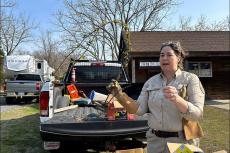As the seasons shift and we head into the fullness of spring, greeted by warmer weather and blooming trees, many people take the opportunity to spend more time outdoors and be more physically active. Many of my patients during this time of year tell me that this is when they will start working on either starting or restarting exercise regimens for their physical fitness, and we often spend time discussing what specific goals for that might look like.
While there are a great number of resources available online and at local fitness centers, some people still wonder what, specifically, they should aim for to optimize their health. Fortunately, a few simple rules of thumb can help guide even those who have been more sedentary to find their way toward improving their physical and cardiovascular health.
As general rules go, I try to encourage patients to start small and slowly build their way up, to avoid injury or discouragement. As with any habits, it’s easy to start aggressively and then become overwhelmed, especially if you pull a muscle or sprain an ankle jogging for the first time in 10 years.
For general cardiovascular health, many organizations, such as the American Heart Association or the American College of Cardiologists, recommend aiming for at least 150 minutes of aerobic activity a week, often averaged to 30 minutes a day for five days a week, or moderate-intensity exercise, or at least 75 minutes a week of vigorous, high-intensity exercise. Examples of moderate-intensity exercise include walking briskly or playing a tennis doubles game, while jogging, running, or playing more vigorous sports like basketball can meet the requirements of vigorous activity. The goal here is not only to get the heart rate up for that period of time but also to find something you enjoy doing on a regular basis so that it is easier to come back to, time and time again.
Many guidelines also recommend trying to work in some strength-training exercises two days or so a week, such as lifting weights at a gym or incorporating light weights into a home routine. This is particularly important for maintaining muscular strength and stability as we age, especially for women in the postmenopausal years as the risk of osteoporosis increases. Here, however, avoiding overexercising is key as well. Muscles take time to recover after workouts, and that recovery period is key to optimal growth and strengthening.
Finally, I also often recommend trying to work in some flexibility exercises a few days a week if possible, in order to maintain good mobility. Examples of this can include yoga, Pilates, or simply daily stretches to help maintain range of motion of your major joints, neck, and back. This can help keep us more able to carry out our daily tasks as we age, and maybe even avoid chronic issues such as neck or back pain, particularly if done in conjunction with strengthening exercises.
For many patients, the reason to start exercising seems to come from a desire to lose weight, but without significant dietary changes, even the most vigorous exercise regime will lead only to modest weight loss. Instead, I advise patients to focus on the other proven benefits of exercise: Improved cardiovascular health, maintained mobility and function in daily living, and positive effects on mood and sleep, as long as you aren’t exercising right before bed. None of us needs to train at the level of a professional athlete by any means, but incorporating some of the above principles into our lives can help keep us healthier and happier throughout our lives.
—
Joshua Potter, D.O., a physician with Stony Brook Southampton Hospital’s Meeting House Lane Medical Practice, oversees the practice’s Shelter Island office. He specializes in family and neuromusculoskeletal medicine. Opinions expressed in this column are his personal and professional views and not necessarily those of his employer.




